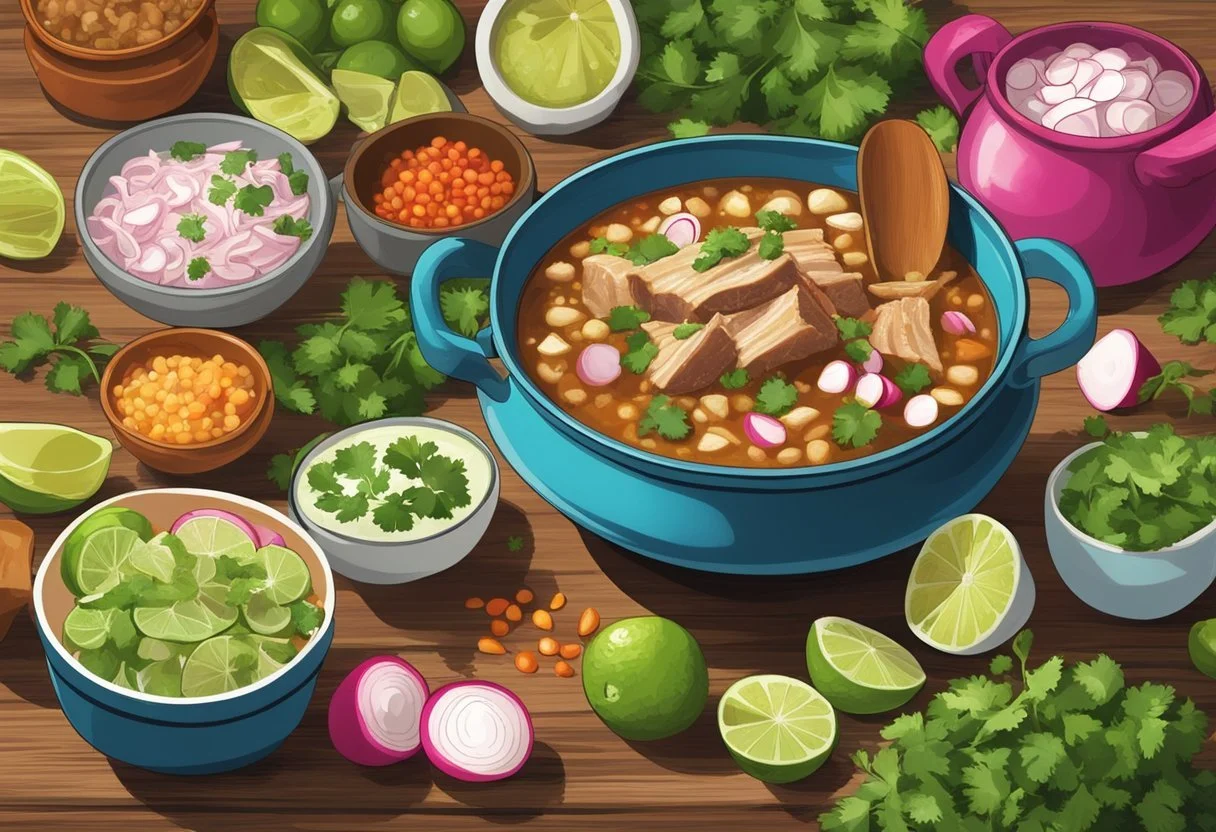Texas Pork Posole
A Flavorful and Hearty Recipe Guide
Discover > Truly Texan > Texas Pork Posole
The Texas pork pozole recipe, a traditional Mexican stew, is gaining popularity among food enthusiasts for its flavorful and hearty combination of ingredients. Known for its rich history and versatility, this dish features slow-cooked pork, hominy, and various spices, creating a warm and comforting meal perfect for cold weather or family gatherings. As a beloved dish in Tex-Mex cuisine, Texas Pork Posole showcases the unique fusion of Mexican culinary traditions with the regional flavors of Texas.
The key to an authentic and delectable Texas Posole or pork and hominy lies in the selection and preparation of its ingredients. Tender chunks of pork shoulder or loin are typically used and, hominy, a type of dried maize, supplies a pleasant chewiness and distinctive corn (how long does corn last?) flavor, distinguishing Posole from other soups (What wine goes well with soups?) and stews (What wine goes well with stews?). A blend of spices, such as chili, cumin, and oregano, which imbue the Posole with a complex and aromatic taste profile.
As versatile as it is, pork and hominy can be adapted to personal preferences. Some add a variety of vegetables, such as bell peppers or zucchini, increasing the dish's nutritional value. Additionally, garnishes like avocado, radishes, and cilantro provide a burst of freshness and contrast with the stew's warm and hearty nature.
History and Origin of Texas Posole
Traditional Significance
The traditional Mexican pozole recipe has roots in both Texas and Mexico. It was traditionally served during celebrations, family gatherings, and cultural events. The process of nixtamalization, which involves treating corn with an alkaline solution to make hominy, played a significant role in the preparation of this dish. This method has been used for centuries in Mesoamerican cooking and is fundamental in transforming the corn's texture, flavor, and nutritional value.
Key ingredients of this dish include:
Hominy (processed corn)
Pork (sometimes replaced with chicken or beef)
Various spices, such as chili, garlic, and oregano
Toppings including cabbage, radish, avocado, and lime
The traditional preparation of pork and hominy involves slow-cooking the meat until it becomes tender pork and the broth acquires a deep, rich flavor.
Variations Across Regions
There are several variations of the Pozole recipe, which can be largely attributed to regional differences. The most distinctive types are Pozole Rojo (red) and Pozole Verde (green). While the foundation of these recipes remains consistent, the preparation and ingredients may vary.
Traditional Pozole Rojo recipe: This pozole recipe, primarily found in Texas but also a Mexican food, (What wine goes well with Mexican food?) gets its vibrant red color from the addition of dried chili peppers. The peppers are soaked, blended, and strained to create a smooth chili sauce that is incorporated into the broth. Ancho and guajillo chilis are commonly used in the Texas variation to provide a bold, smoky flavor.
Pozole Verde: Popular in Mexico, this dish is characterized by its green color, which is attributed to the use of fresh ingredients such as tomatillos, jalapeños, and cilantro (how long does cilantro last?). Unlike Pozole Rojo, this version incorporates chicken instead of pork.
Essential Ingredients
Pork Selection
When making a Texas Posole recipe, selecting the right cut of pork is crucial. Pork shoulder (also known as pork butt) is the preferred cut, as it is tender and flavorful. It is also ideal for slow cooking, which produces tender almost shredded pork, which absorbs the rich flavors of the dish.
Hominy: The Key Staple
Hominy, a type of dried corn (how long does dried corn last?) Mexican food, is the staple ingredient in Texas Posole. Through a process called nixtamalization, the corn is treated with an alkaline, usually lime water, which softens the outer hull and removes the germ. This creates a softer, more tender corn kernel with a unique taste and texture. It is available in canned or dried form, but canned hominy is more convenient, as it does not require overnight soaking.
Signature Spices and Herbs
Texas Posole is characterized by its blend of spices and herbs, which give the dish its distinctive flavor. Here is a list of the primary flavors used in the posole recipe:
Onion and garlic: These aromatic vegetables provide a foundation for the dish and are typically sautéed with the pork to enhance flavor.
Chicken broth (how long does chicken broth last?) or broth: The liquid base of the stew, it adds richness and depth of flavor. Beef or vegetable broth (how long does vegetable broth last?) can also be used.
Salt: Necessary for seasoning and balancing flavors.
Cumin: A warm, earthy spice that adds depth to the dish. It is often used in Texan and Mexican cuisine.
Dried oregano (how long does dried oregano last?): Gives the dish a subtle herbal note. Mexican oregano is the preferred variety, as it has a stronger flavor than its Mediterranean counterpart.
Chili powder is a key ingredient that provides heat and a bold, smoky flavor. Adjust the amount to personal preference and desired level of spiciness.
Take advantage of the wide variety of options when you shop for chicken broth, cumin, dried oregano, and chili powder online!
Cooking Techniques
Preparing the Pork
Before cooking, it is crucial to properly prepare the pork for your Texas pork and hominy. Trim any excess fat from the pork shoulder, and then cut it into roughly 1-inch cubes. Season the pork generously with salt and pepper. In a large Dutch oven, heat about 2 tablespoons of canola oil over medium heat. Add the pork cubes, ensuring they are evenly seared on all sides. Don't overload the pan so the meat can brown. This step helps to develop a rich flavor and appealing color in your Posole.
Get the best value for your money by purchasing a Dutch oven and canola oil online!
Simmering
Typically, any Texas Posole recipe requires gentle simmering to develop its unique flavor and tenderness. Follow the steps below:
Boil: Add enough water to cover the meat by about 1 inch. Bring to a boil over high heat. Keep an eye on the pot to avoid boiling over.
Simmer: Lower the heat, maintaining a gentle simmer. Cooking at a slow simmer allows the pork to become tender and flavors to meld, enhancing the dish's overall taste. Continue simmering for about 2 hours, or until the meat is fork-tender.
Using a Slow Cooker
A slow cooker is a great alternative for making Texas Posole for those looking for a more hands-off approach. Follow these simple steps:
After searing the pork in the Dutch oven (as outlined in "Preparing the Pork" section), transfer the browned meat to a slow cooker.
Add other Posole ingredients, ensuring the slow cooker is filled no more than three-quarters full.
Set the slow cooker on low heat for 6 to 8 hours, or on high heat for 4 to 6 hours. This slow simmering process will allow the flavors to meld and create a delectable dish.
The key to a successful Posole lies in the slow simmering which develops the rich flavors and tender pork.
Trust me, the easiest way to buy a slow cooker is through online retailers!
Serving and Accompaniments
Garnishes and Toppings
To elevate the flavor and presentation of Texa Posole, garnishes and toppings play an essential role. Some popular and complementary garnishes include:
Cilantro: This vibrant, aromatic herb adds flavor and color.
Radishes: Thinly sliced, the radishes contribute a lovely crunch and a slight peppery taste.
Lime wedges: Squeezed over the Posole just before eating, lime enhances the soup's brightness and acidity.
Avocado: Creamy and rich, diced avocado is a delicious contrast to the rich Posole.
In addition, shredded lettuce can provide an extra layer of texture, while crisp tortilla chips (how long do tortilla chips last?) or tostadas may be served alongside or crumbled on top of the warm soup.
Side Dishes
For those looking to offer a more comprehensive meal, pair Texas Posole with an array of delicious side dishes. Here are a few suggestions:
Tortillas: Soft, warm tortillas are ideal for dipping into the flavorful Posole broth or wrapping some of the meat and vegetables. You can serve them alone or with a variety of fillings, such as:
Refried beans
Cheese
Mexican rice
Salad: A light salad, like a basic green salad or a tangy shredded cabbage coleslaw, complements the hearty flavors of the Posole.
Soup bowls: Try serving Posole in stylish soup bowls. Encourage guests to customize their bowls with a variety of the mentioned garnishes and toppings to suit their tastes.
Tortilla chips
Customizing Your Posole
Vegetarian and Vegan Variations
For vegetarians or vegans, it's easy to modify the traditional Texas Posole recipe. Replace the pork with a plant-based protein, such as tofu or tempeh (how long does tempeh last?), and use vegetable broth (how long does vegetable broth last?) instead of chicken or pork broth.
Or use a variety of hearty vegetables like zucchini, bell peppers, squash and shredded cabbage. To ensure a rich and flavorful broth, consider adding hominy - a type of dried maize that is often used in posole recipes - as it gives the dish its signature texture and taste. For even more depth of flavor, use a combination of dried chilies like Ancho, Guajillo, and Cayenne Pepper.
Adjusting Heat Levels
To customize the heat level of your posole, choose from a range of chili options:
For a mild heat level, stick to Ancho chilies. In contrast, use Cayenne Pepper for a hot and spicy posole. For medium heat and a more complex flavor, combining Guajillo chilies with either Ancho or Cayenne creates a well-rounded taste.
Moreover, fresh peppers can be added in addition to dried chilies. Options include Jalapenos for moderate heat and Poblano Peppers for a milder flavor. A quick note, removing the seeds and membranes from these peppers will further reduce their heat levels.
Finally, don't forget about tomatillos. These small, green, tomato-like fruits are acidic in taste and provide a contrast to the heat. They can be added fresh, roasted, or as a salsa to balance the dish.
Storage and Reheating
Preserving Leftovers
After enjoying a delicious meal of Texas Posole, it is important to store any leftovers to maintain freshness and taste. First, allow the Posole to cool down to room temperature, which should take roughly 30 minutes. Once cooled, transfer the leftover Posole into an airtight container to prevent any contamination. Often the texture and flavor of leftover posole improves when stored and the meat is even more tender and like shredded pork.
Leftovers can be stored in the refrigerator or freezer. For short-term storage of up to 4 days, place the container in the refrigerator. However, for longer storage (up to 3 months), opt for the freezer.
Best Practices for Reheating
To reheat your Texas Posole, follow these guidelines:
Refrigerated Posole:
Remove the container from the refrigerator and allow it to rest at room temperature for 15-20 minutes.
Pour the Posole into a saucepan or pot; avoid using a microwave to prevent uneven heating.
Reheat it over low-medium heat, stirring occasionally to prevent sticking.
Once the Posole reaches a safe temperature of 165°F (74°C), you can serve and enjoy it again!
Frozen Posole:
Thaw the frozen Posole in the refrigerator for a day or use a microwave with its defrost setting.
After thawing, follow the reheating steps above for refrigerated Posole.
Nutritional Information
Posole is a traditional Mexican soup that is both delicious and packed with essential nutrients. Its primary ingredients include pork, hominy, and a variety of herbs, spices, and vegetables. In this section, we will focus on the nutritional aspects of the dish.
A typical serving of Posole contains approximately 350-400 calories. The majority of these calories come from the protein-rich pork and the carbohydrate-dense hominy. It is important to remember that individual recipes may vary, so the actual caloric content may be slightly higher or lower depending on preparation methods and added ingredients.
When diving deeper into the macronutrients, a standard serving of Posole offers the following approximate values:
Protein: 25-30 grams
Fat: 10-15 grams
Carbohydrates: 35-40 grams
The nutrition of Posole will vary depending on the recipe used. Lean cuts of pork, such as loin or tenderloin, can be used to decrease the total fat content and increase the healthiness of the dish. Additionally, incorporating more vegetables and using a low-sodium broth will boost the nutritional value of the soup.
Posole is also a good source of essential vitamins and minerals. Some key nutrients include:
Vitamin A: found in tomatoes and chili, important for maintaining healthy vision and immune function.
Vitamin C: found in tomatoes and bell peppers, known for its antioxidant properties and essential role in collagen production.
Potassium: found in hominy and pork, essential for maintaining proper muscle function and balancing fluid levels in the body.
Tips and Tricks
Improving Flavor Depth
To elevate the taste of your Texas Posole, consider incorporating these techniques to enhance the flavor depth:
Masa: Adding a touch of masa can significantly thicken the soup while also contributing to its rich taste. Mix it with water to create a slurry, and then gently stir it into the posole.
Beer: Introduce a unique twist by including beer in your recipe. It is advised to choose dark or amber beers, as they will best complement the savory flavors of the posole.
Bone: To maximize the richness of your broth, opt for bone-in pork cuts. Simmering the meat and bone together infuses the broth with a greater depth of flavor. Remember to remove any excess fat before cooking.
Achieving the Perfect Consistency
There are multiple ways to achieve a desirable consistency in your Texas Posole. Here are some suggestions to do so:
Water ratio: Be mindful of the water-to-ingredient ratio in the posole. Adding too much water may dilute the consistency, while too little may cause the soup to be overly thick. To achieve the perfect balance, gradually add water and adjust as needed.
Blender: Utilizing a blender can help achieve a smooth and consistent texture. For this step, remove a portion of the cooked hominy and blend it until smooth. Once blended, reincorporate it into the posole to obtain a desirable consistency.
Always remember to be confident and deliberate in your approach, maintaining a neutral, knowledgeable stance while considering these tips to enhance your Texas Posole.
FAQs and Common Mistakes
Selecting the Right Cut of Pork
One common mistake when making Texas Posole is using the wrong cut of pork. It's crucial to select a cut that has an ideal mix of meat and fat. The pork shoulder or pork butt are the most suitable choices for this dish. These cuts are flavorful, tender, and have enough fat to keep the meat moist during the cooking process.
Here are some FAQs concerning choosing the right cut of pork:
Can I use pork loin instead? While it's possible, pork loin tends to be leaner. This could result in a drier and less flavorful end result.
How much meat should I buy? Plan for approximately 4-6 ounces of raw meat per person. This should account for any trimming needed.
Balancing Spices for Authentic Flavor
Achieving the perfect balance of spices is crucial for an authentic Texas Posole experience. While it's essential to follow the recipe, it's also worthwhile to adjust the spices to your liking, considering factors such as personal taste and spice tolerance.
Here's a table of recommended spices for Posole and their functions:
Keep in mind these tips when balancing spices:
Start with a smaller quantity of spices, particularly chili powder, and gradually increase them to your desired heat level.
Taste the Posole as you go, making small adjustments to the spices until you achieve the perfect balance for your palate.
Consider adding a squeeze of lime or a sprinkle of cilantro at the end to brighten the flavors.
Remember that it's easier to add spices than to remove them — allow your culinary intuition and personal preferences to guide you as you build a delicious and authentic Texas Posole.
Posole Variations and Recipes
Posole, a popular Mexican soup, has several variations based on regional differences and individual preferences. Two of the most well-known and distinct versions of this dish are Pozole Verde and Pozole Rojo.
Pozole Verde
Pozole Verde, also known as green pozole, is known for its bright, tangy flavors and vibrant appearance. The base of this recipe consists of tomatillos, green chiles, and fresh herbs such as cilantro, resulting in a rich, green broth. To make Pozole Verde, one can use chicken as the main protein, along with a generous portion of chicken broth. This variation is both delicious and healthy, as it is lower in fat than other types of pozole.
Ingredients for Pozole Verde:
2 lbs chicken, cut into pieces
8 cups chicken broth
Fresh tomatillos
Green chiles, such as jalapenos or serranos
Cilantro
Onion, garlic, and salt, to taste
Consider following a step-by-step guide for a more detailed recipe, but remember that individual adjustments can be made depending on personal preferences and ingredient availability.
Pozole Rojo
Pozole Rojo is characterized by its deep, red color and robust flavor. This variation employs red chile peppers, such as Guajillo and Ancho chiles, to create a rich, smoky base. Pozole Rojo commonly features pork, but chicken can also be used as a protein alternative. The recipe also typically includes hominy, adding a textural contrast and enhancing the overall heartiness of the dish.
Ingredients for Pozole Rojo:
2 lbs pork, cut into bite-sized pieces (or substitute chicken)
8 cups chicken broth
Dried red chiles (Guajillo, Ancho, or a combination of both)
Hominy (canned or dried)
Onion, garlic, and salt, to taste
Again, it's beneficial to follow a detailed recipe when tackling Pozole Rojo, ensuring proper balance and melding of flavors.
While different, both Pozole Verde and Pozole Rojo are equally delicious and satisfying, enjoyed by people worldwide. No matter the variation, posole is typically served with a variety of toppings such as cabbage, radishes, avocado, and lime, allowing each person to customize their experience and savor this delicious Mexican dish.
Conclusion
In summary, Texas Posole is a delightful and flavorful dish that showcases the best of Texan and Mexican culinary influences. With its unique combination of pork, canned hominy, and chiles, this dish is as hearty as it is delicious.
A fundamental aspect of Texas Posole is its versatility. It can be customized to suit individual tastes through the addition of various garnishes, such as:
Diced avocado
Chopped cilantro
Sliced radish
Lime wedges
An essential element to consider when preparing Texas Posole is the quality of ingredients. Opting for fresh chiles and hominy will greatly enhance the overall flavor and texture of the dish. Additionally, it is crucial to keep in mind the cooking time for the pork, as it ensures the meat's tenderness and proper blending of flavors.
Finally, enjoy the experience of preparing and sharing Texas Posole with family and friends. The act of sharing this mouth-watering dish not only brings people together but also creates an opportunity to introduce others to the rich culinary heritage that Texas represents.







